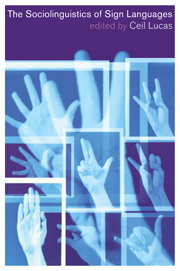Book contents
- Frontmatter
- Contents
- List of figures
- List of tables
- List of contributors
- Foreword
- Preface and acknowledgments
- List of abbreviations
- 1 Introduction
- 2 Multilingualism: The global approach to sign languages
- 3 Bilingualism and language contact
- 4 Sociolinguistic variation
- 5 Discourse analysis
- 6 Language planning and policy
- 7 Language attitudes
- Bibliography
- Index
4 - Sociolinguistic variation
Published online by Cambridge University Press: 24 November 2009
- Frontmatter
- Contents
- List of figures
- List of tables
- List of contributors
- Foreword
- Preface and acknowledgments
- List of abbreviations
- 1 Introduction
- 2 Multilingualism: The global approach to sign languages
- 3 Bilingualism and language contact
- 4 Sociolinguistic variation
- 5 Discourse analysis
- 6 Language planning and policy
- 7 Language attitudes
- Bibliography
- Index
Summary
[George Trager and Henry Lee Smith] insisted that language could not be studied by itself, in isolation, but must be looked at in direct connection to the people who used it, the things they used it to talk about, and the view of the world that using it imposed on them.
Stokoe (1994: 333)Language varies both in space and in time, as well as according to the linguistic environment in which a form is used. For example, the American Sign Language (ASL) sign DEAF has three possible forms. It can be produced with a movement from ear to chin (the citation or dictionary form), with a movement from chin to ear, or simply by contacting the cheek once (both non-citation forms). Even though the form of DEAF varies from signer to signer and even within the signing of the same signer, the variation we observe is far from random. Rather, signers' choices among the three forms of DEAF are systematically constrained by a range of factors at both the linguistic and the social levels. Thus, compared to signers in other parts of the USA, signers in Boston, Massachusetts tend to be quite conservative in the choice of a form of DEAF. In contrast, signers in Kansas, Missouri and Virginia tend to prefer non-citation forms. Indeed, a recent study conducted by three of the authors of this chapter showed that signers in these states used non-citation forms of DEAF 85 percent of the time, more than twice the rate of signers in Boston (Bayley et al., 2000; Lucas et al., 2001).
- Type
- Chapter
- Information
- The Sociolinguistics of Sign Languages , pp. 61 - 111Publisher: Cambridge University PressPrint publication year: 2001
- 21
- Cited by



